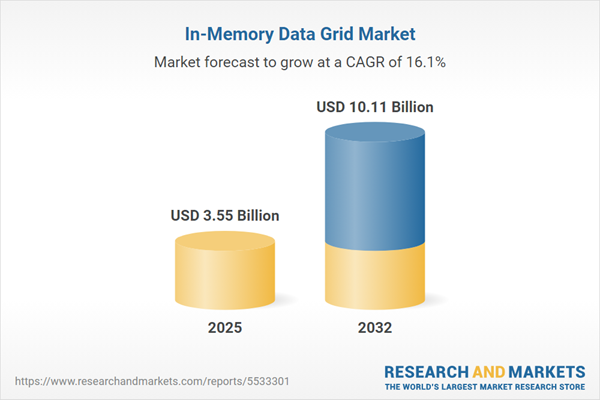Speak directly to the analyst to clarify any post sales queries you may have.
Senior leaders are increasingly focusing on advanced in-memory data grid solutions to enhance operational resilience, support digital transformation, and respond rapidly to changing business needs. These platforms provide the adaptability essential for business continuity and a competitive edge in fast-evolving industries.
Market Snapshot: In-Memory Data Grid Market Overview
The in-memory data grid market is exhibiting sustained global expansion, propelled by the escalating need for real-time analytics and effortless system scalability. The market is forecast to grow from USD 3.07 billion in 2024 to USD 3.55 billion in 2025, ultimately reaching USD 10.11 billion by 2032. This reflects a compound annual growth rate of 16.06%. Early uptake is particularly marked in financial services, utilities, telecommunications, and retail. These sectors rely on accelerated data processing and improved operational oversight for strategic value. Central market drivers include immediate data accessibility and automated workflows, reinforcing in-memory data grids as a key technology underpinning robust digital operations.
Scope & Segmentation of the In-Memory Data Grid Market
This report delivers an in-depth analysis for IT and business leaders aiming to shape technology investments and compliance frameworks with confidence. Segmentation allows organizations to tailor deployment strategies based on industry-specific regulatory demands, digital maturity, and innovation goals.
- Data Types: Support for structured records, unstructured data, event streams, and binary sources enables organizations to pursue analytics-fueled solutions and predictive business applications.
- Component: Managed services, consulting, proprietary software, and open-source frameworks reflect the breadth of integration models available, from initial cloud entry through advanced hybrid environments.
- Organization Size: Solutions serve both large enterprises and mid-sized businesses, providing scalability to align with diverse governance and operational needs.
- Deployment Mode: Enterprises have flexible choices including public cloud, private cloud, hybrid, or on-premises deployment, supporting varied risk profiles and compliance requirements.
- Application: The technology is applied in banking, healthcare, government, defense, energy, telecommunications, and life sciences, allowing clients to address unique compliance and operational priorities.
- Regions: Adoption spans the Americas, Europe, Middle East, Africa, and Asia-Pacific, with regional factors such as digital infrastructure, market drivers, and local regulations shaping solution uptake.
- Leading Companies: Key market participants include Oracle, IBM, SAP SE, Microsoft, Redis Ltd., VMware, Hazelcast, TIBCO Software, GridGain Systems, and Software AG, all contributing innovation in integration, security, and performance.
Key Takeaways for Senior Leaders
- In-memory data grid solutions facilitate real-time business intelligence, supporting agile planning and responsive business process management for dynamic markets.
- Utilizing cloud-native and hybrid deployments allows organizations to scale seamlessly and meet regulatory or operational shifts efficiently.
- Integration with microservices, edge computing, and artificial intelligence enhances IT flexibility and unlocks new innovation avenues for enterprises adapting to digital disruption.
- Security is elevated through the adoption of adaptive frameworks and advanced encryption, enabling compliance with evolving regulatory standards and safeguarding sensitive workloads.
- Pervasive deployment and integration models give industries the flexibility to align IT infrastructure with specific operational targets, increasing reliability and compliance assurance.
- Progress in interoperability and AI-driven workflows sustains digital operations and reduces operational downtime, reinforcing organizational resilience.
Tariff Impact on Procurement and Supply Chain
Recent changes in U.S. tariffs are prompting enterprises to reevaluate technology procurement strategies for in-memory data grid solutions. Businesses are diversifying supplier relationships and adjusting sourcing models to minimize supply risk and maintain steady access to required technologies. Legal and procurement teams are emphasizing flexible contracting practices to guard against disruptions within increasingly complex global technology supply chains.
Methodology & Data Sources
This analysis is based on research from reputable technology publications, comprehensive secondary industry studies, and direct input from senior IT leaders and solution architects. Market insights are validated against established standards and current benchmarks to provide reliable and actionable findings.
Why This Report Matters
- Delivers a practical framework for shaping in-memory data grid strategies in response to the continual evolution of regulatory, operational, and technological requirements.
- Enables risk mitigation and procurement agility by presenting contract and sourcing methods tailored to global business challenges.
- Guides senior leaders with best practices for achieving scalable deployments and measurable operational improvements across core enterprise sectors.
Conclusion
In-memory data grids are central to driving digital advancement across industries. This report equips senior decision-makers to capture value at all stages of adoption and maintain organizational agility as markets and regulations evolve.
Additional Product Information:
- Purchase of this report includes 1 year online access with quarterly updates.
- This report can be updated on request. Please contact our Customer Experience team using the Ask a Question widget on our website.
Table of Contents
3. Executive Summary
4. Market Overview
7. Cumulative Impact of Artificial Intelligence 2025
Companies Mentioned
The companies profiled in this In-Memory Data Grid market report include:- Oracle Corporation
- International Business Machines Corporation
- SAP SE
- Microsoft Corporation
- Redis Ltd.
- VMware, Inc.
- Hazelcast, Inc.
- TIBCO Software Inc.
- GridGain Systems, Inc.
- Software AG
Table Information
| Report Attribute | Details |
|---|---|
| No. of Pages | 180 |
| Published | October 2025 |
| Forecast Period | 2025 - 2032 |
| Estimated Market Value ( USD | $ 3.55 Billion |
| Forecasted Market Value ( USD | $ 10.11 Billion |
| Compound Annual Growth Rate | 16.0% |
| Regions Covered | Global |
| No. of Companies Mentioned | 11 |









